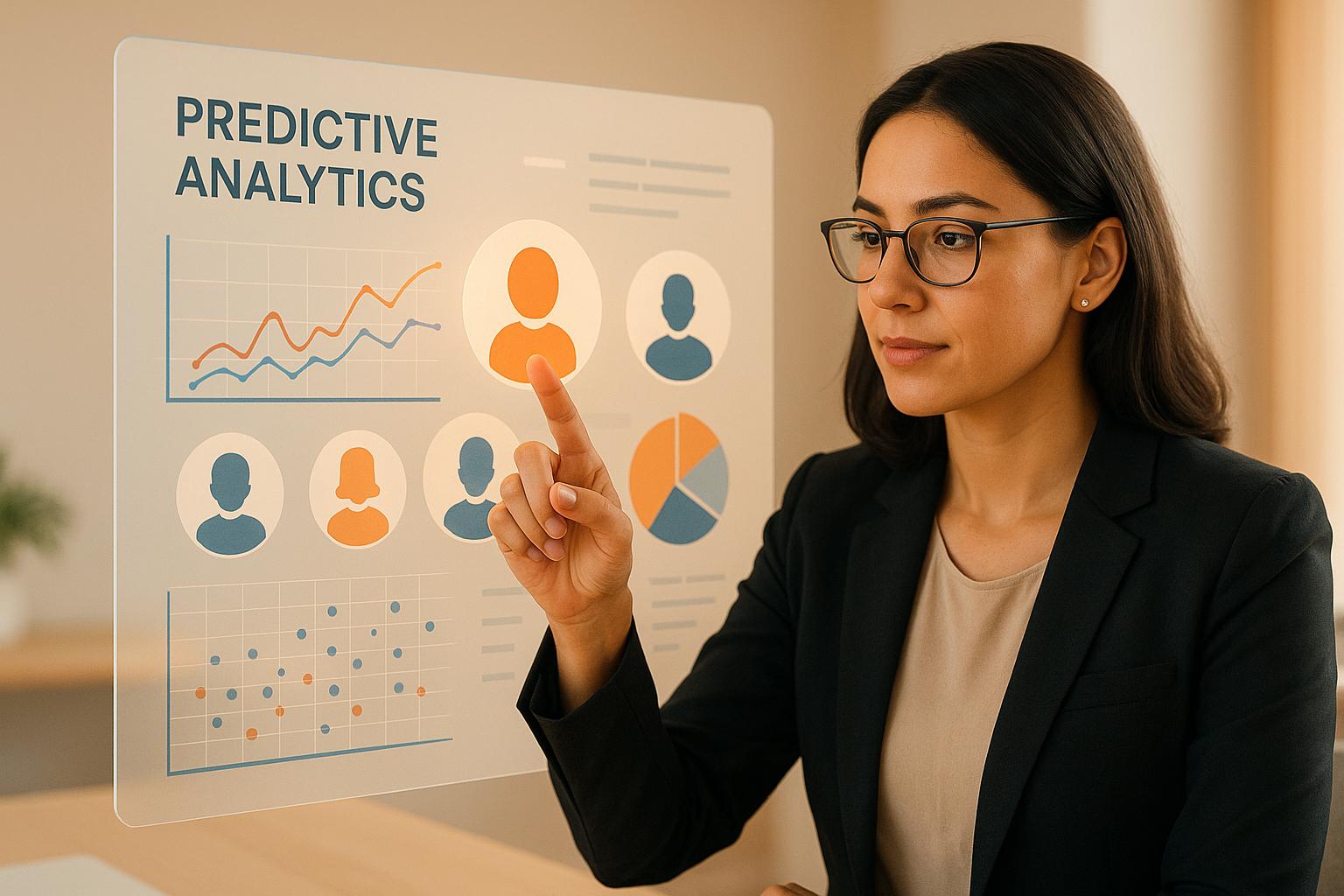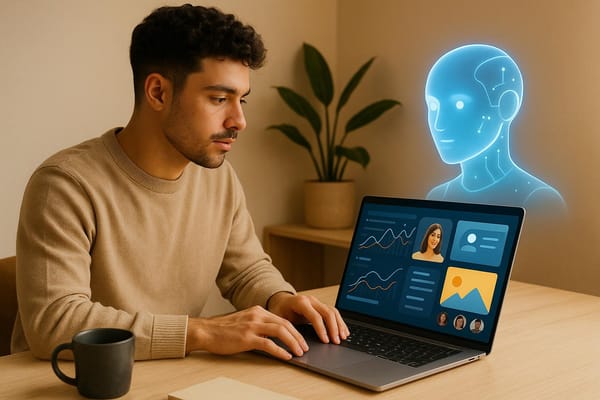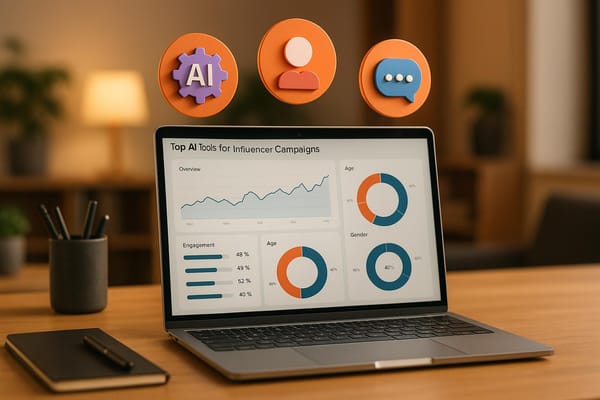Influencer Marketing vs PR: Complete Comparison
Explore the differences between influencer marketing and PR, their goals, execution, audience perception, and how they can work together for brand success.
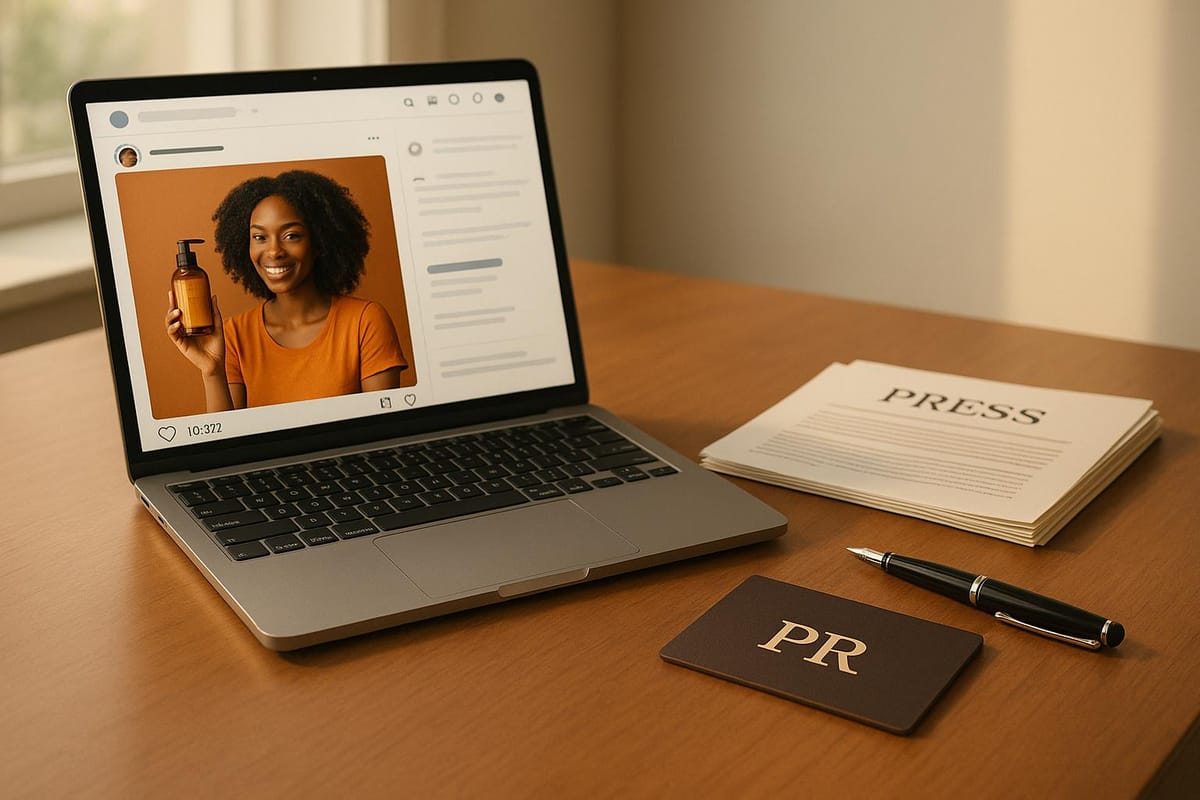
Which is better: influencer marketing or PR? It depends on your goals. Influencer marketing is great for quick results like sales or engagement, while PR focuses on building long-term trust and reputation. Both can work together to amplify your brand.
Here’s a breakdown:
- Influencer Marketing: Works with individuals who have loyal followers to promote products. It’s campaign-driven with measurable results like sales and engagement. For every $1 spent, businesses see an average return of $5.78.
- PR (Public Relations): Focuses on earned media (like press coverage) to build credibility. It’s more about managing reputation and relationships over time, offering independent validation through media outlets.
Quick Comparison
| Aspect | Influencer Marketing | Public Relations (PR) |
|---|---|---|
| Goal | Immediate actions (sales, awareness) | Long-term trust and reputation |
| Execution | Paid collaborations with influencers | Organic media coverage |
| Audience View | Seen as paid promotion | Viewed as unbiased validation |
| Metrics | Engagement, conversions, ROI | Media coverage, sentiment, trust |
Key takeaway: Use influencer marketing for fast, measurable impact and PR for credibility and sustainable growth. Combining both creates a stronger, balanced strategy.
How digital PR & influencer marketing work together to build a brand
Key Differences: Goals, Execution, and Audience Perception
Building on their distinct purposes, influencer marketing and public relations (PR) diverge significantly in their goals, strategies, and how they are perceived by audiences. While both aim to enhance brand visibility, their methods and outcomes are tailored to different business needs. Understanding these differences is crucial for selecting the right approach based on objectives and timelines.
Comparison of Goals
Influencer marketing is all about achieving quick, measurable results. For instance, 35.6% of campaigns focus on driving sales, while 24.4% aim to boost brand awareness. Scott Sutton, CEO of Later, highlights this shift:
Today, influencer marketing can be seen as a core growth engine as we witness its transformation from experimental to essential.
PR, on the other hand, takes a longer-term view. Its primary focus is on building credibility and managing the brand's reputation over time. Instead of immediate sales, PR seeks to establish trust and cultivate enduring relationships with media outlets and stakeholders. This approach lays the groundwork for sustainable growth. Meanwhile, influencer marketing is evolving into a more strategic effort, with brands allocating larger budgets to campaigns that deliver scalable results.
Differences in Execution
The execution of influencer marketing is largely transactional. Brands partner with content creators through paid collaborations, often structured around specific campaigns with clear deliverables, timelines, and compensation. Recently, there has been a shift toward working with micro- and nano-influencers to achieve better engagement and cost efficiency.
Sherry Wu, Associate Director at Boston Consulting Group, explains:
Brands are increasing influencer investments but face scalability challenges and lack consistent in-house expertise.
PR, in contrast, relies on organic, relationship-driven tactics. It involves crafting press releases, pitching stories to journalists, and building genuine connections with media professionals to secure earned media coverage. While influencer marketing uses AI tools for creator selection and performance tracking, PR focuses on media monitoring and managing brand reputation. These distinct approaches also shape how audiences perceive each strategy.
Audience Perception
Despite concerns about transparency, influencers hold sway over consumer trust. About 69% of consumers trust influencers, and 49% take action based on their recommendations. Authenticity plays a key role: 61% of consumers prefer influencers who are relatable, compared to just 11% who favor celebrities. Micro-influencers, in particular, excel here, generating up to 60% more engagement, with an average Instagram engagement rate of 3.86%, compared to 1.21% for mega-influencers.
PR, however, benefits from the credibility of earned media. When a journalist or editor covers a brand, the endorsement feels unbiased, offering a sense of independent validation. This resonates strongly with audiences seeking trustworthy recommendations, further distinguishing PR from influencer marketing.
Comparison Table
| Aspect | Influencer Marketing | Public Relations (PR) |
|---|---|---|
| Primary Goal | Drive immediate actions and product launches, leading to measurable sales conversions | Build long-term credibility and sustain a strong brand reputation |
| Execution | Transactional, campaign-driven content | Organic, relationship-driven earned media |
| Audience Perception | Often perceived as paid promotion, though many consumers trust influencer recommendations | Seen as authentic endorsements and genuine recommendations |
Performance Metrics and ROI: How to Measure Success
When it comes to assessing the success of influencer marketing versus PR, the tools and metrics used are quite different. While both aim to enhance brand visibility, their measurement methods reflect their unique goals and execution styles. Understanding these differences is key to allocating budgets wisely and showing real business impact. These tailored metrics help marketers fine-tune their strategies for better campaign performance.
Metrics for Influencer Marketing
Influencer marketing thrives on numbers that show immediate results. Key metrics include engagement rates, reach, impressions, and direct conversions. Interestingly, 70% of marketers actively measure the ROI of their influencer campaigns, though 13.6% still find it challenging to track these efforts effectively. On average, this channel delivers a return of $5.20 for every $1 spent, making ROI tracking an essential part of justifying budgets.
Successful campaigns often use layered attribution models to track performance. For example, USIMS' NeoReach campaign led to 300,000 eSIM downloads. Similarly, HelloFresh collaborated with TikTok influencers through House of Marketers, achieving more than 500 monthly sales via promo codes.
To ensure measurable outcomes, marketers use tools like UTMs, unique landing pages, and promo codes. Take Rocky Mountain Chocolate Factory, for instance - they teamed up with AdParlor for National Caramel Apple Day and saw a 26% year-over-year sales increase. ASUS also leveraged influencer partnerships through The Influencer Marketing Factory to promote the Zenbook 14x OLED, racking up 597,000 views and 29,500 likes on YouTube.
Metrics for PR
PR, on the other hand, leans on both qualitative and quantitative data, focusing on brand sentiment, media coverage, earned media value, and audience trust. Unlike influencer marketing, which often tracks immediate consumer actions, PR's impact is more about long-term reputation and relationship building.
Media monitoring tools like CisionOne and Meltwater help track media coverage, brand sentiment, website traffic, and social media engagement. These insights reveal how PR efforts translate into earned media value and shifts in audience perception. For example, Nivea’s "Living in My Skin" podcast, featuring key influencers, achieved nearly 100% positive sentiment. MLB partnered with the GOAT Agency to introduce baseball to the U.K., generating an earned media value of £32,992. Pernod Ricard also worked with the GOAT Agency to promote Beefeater Pink gin, leading to a staggering 1,500% increase in organic user-generated content.
PR metrics capture a mix of immediate media coverage and long-term brand growth. Sentiment analysis, message penetration, and stakeholder feedback provide valuable insights into a campaign's performance. Additionally, advancements in AI and machine learning are enhancing data analysis and offering predictive insights for future campaigns.
Comparison Table
| Metric Category | Influencer Marketing | Public Relations |
|---|---|---|
| Reach & Awareness | Impressions, Reach, Audience Growth | Media Coverage, Share of Voice, Social Media Mentions |
| Engagement | Likes, Comments, Shares, Saves, Engagement Rate | Social Engagement, Sentiment |
| Traffic & Conversions | Click-Through Rate, Conversions, Revenue, Affiliate Link Performance | Referral Traffic, Conversion Rates from PR-Driven Traffic |
| Brand Perception | Sentiment Analysis, Brand Mentions | Sentiment Analysis, Message Penetration, Stakeholder Feedback |
| ROI | ROI, Cost Per Acquisition (CPA), Earned Media Value (EMV) | Earned Media Value (EMV), Impact on Business Objectives |
Influencer marketing relies heavily on direct tracking tools like UTM parameters, custom landing pages, and promo codes. PR, on the other hand, uses methods like correlation analysis and qualitative assessments. Both strategies benefit from setting SMART goals - Specific, Measurable, Achievable, Realistic, and Time-bound - to ensure actionable insights. By focusing on integrated analytics, brands can align influencer marketing and PR efforts, creating a cohesive strategy that supports broader marketing and sales goals. Tools like Media AI make it easier to bridge these approaches for well-rounded campaign success.
AI-Powered Tools for PR and Influencer Marketing
Artificial intelligence is reshaping how brands approach PR and influencer marketing. By leveraging AI tools, marketers can analyze data, predict outcomes, and automate repetitive tasks. For US-based brands, this shift offers a chance to stretch marketing budgets while achieving measurable results.
How AI is Changing Campaigns
AI is making campaign management more efficient for both PR and influencer marketing. In fact, 60% of marketers rely on AI for tasks like identifying influencers, optimizing campaigns, and measuring performance, with 66.4% reporting better results as a result.
One of the biggest advancements lies in influencer discovery. AI algorithms sift through massive datasets to find influencers who align with a brand’s target audience, considering factors like demographics, psychographics, and location. This goes beyond just follower counts - AI evaluates whether an influencer’s content and values match the brand’s style and audience.
Content creation and optimization are also seeing improvements. AI tools can suggest content ideas and tailor messaging to fit both the influencer’s tone and the brand’s voice. These tools even analyze audience behavior to determine the best times and platforms for distribution. Some companies have reported up to a 30% boost in marketing efficiency using these data-driven strategies.
Fraud detection is another game-changer. AI can identify fake followers and artificial engagement patterns, and its network analysis capabilities can expose collusion among accounts engaging in deceptive practices.
Perhaps most impressively, AI enables real-time campaign adjustments. Instead of waiting until the end of a campaign to evaluate results, AI tools can tweak strategies mid-campaign based on live data, helping brands maximize outcomes.
Media AI: Features and Benefits
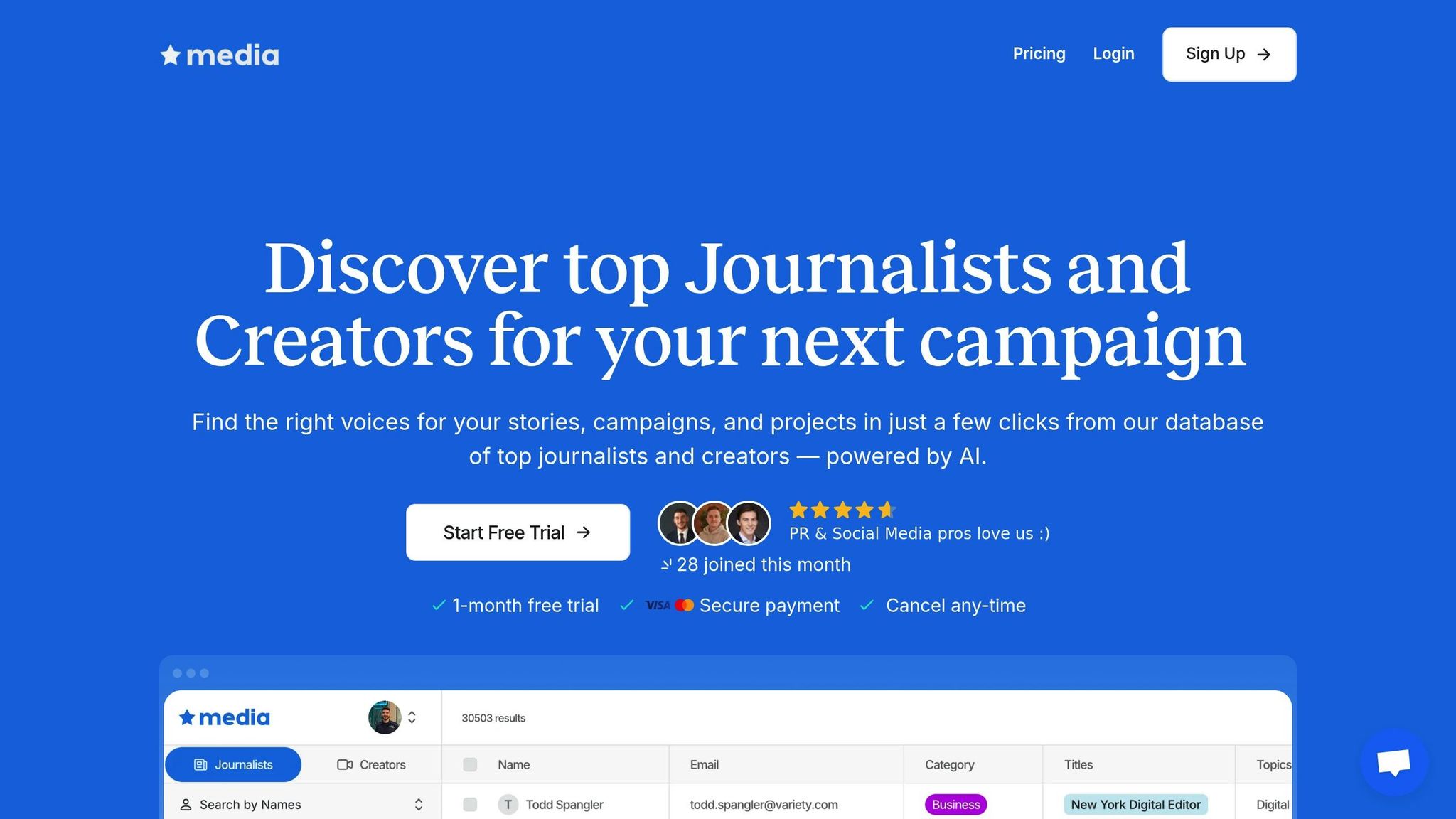
Media AI is designed to address the challenges US brands face in merging influencer marketing with PR. Its platform offers access to over 30,000 journalists and creators in one database, making it easier to run campaigns that combine traditional media outreach with influencer partnerships.
The platform’s advanced filtering allows brands to quickly find collaborators who match their audience demographics, content themes, and engagement styles. Whether you need a tech journalist covering AI startups or a lifestyle influencer in a specific city, Media AI identifies the right fit using precise criteria.
Pricing is straightforward with no long-term commitments:
- Journalist Database: $99/month
- Creators Database: $99/month
- Full Access: $149/month
This flexible approach lets brands scale their efforts according to campaign needs.
Media AI also simplifies workflows with export functionality. Teams can easily extract contact details and campaign data, which is especially helpful for agencies juggling multiple clients or brands managing several campaigns at once. Plus, the platform keeps its contact information up-to-date, solving one of PR’s biggest headaches: outdated data.
Another standout feature is its performance prediction capability. By analyzing historical data and current trends, Media AI helps brands forecast which collaborations are likely to succeed. This allows for smarter budget allocation and more effective campaign planning.
Adding Influencer Marketing to PR Efforts
Media AI’s unified platform makes it easier to integrate influencer marketing into traditional PR strategies. With 92% of brands either already using or open to using AI for influencer marketing, tools like Media AI are paving the way for seamless integration.
This integration enables unified storytelling. PR teams can access both journalists and creators through one platform, crafting cohesive narratives that span traditional media and social channels. This approach amplifies the brand’s message, creating multiple touchpoints with the target audience.
Another advantage is cross-platform attribution. By coordinating PR and influencer campaigns, brands can better track how different types of coverage contribute to overall success. AI-powered insights and personalized strategies have been shown to improve conversion rates by up to 20%.
Cost efficiency is another benefit. Integrated campaigns reduce the need for multiple vendors and tools, while AI automates up to 70% of routine tasks, such as influencer outreach, contract management, and content approvals.
Finally, authenticity gets a boost when influencers and journalists work together on shared campaign themes. Influencers bring relatability and social proof, while journalists add credibility and third-party validation. Together, they create a more engaging and trustworthy brand story.
The key to success lies in balancing automation with the human touch. While AI handles data analysis and optimization, building genuine relationships with journalists and influencers remains a human job. The most effective campaigns use AI to enhance creativity and strategy, not replace them.
Choosing the Right Strategy or Using Both
Deciding between influencer marketing and PR isn’t always straightforward. The best choice depends on your business goals, target audience, and the resources you have at your disposal. Understanding where each strategy shines - and how combining them can amplify results - can make all the difference in your marketing efforts.
When to Choose Influencer Marketing
Influencer marketing works best when you need to create buzz quickly and drive immediate action. For instance, launching a new product or entering a competitive market? Influencers can help you grab attention fast and encourage quick adoption. Their ability to generate rapid engagement often outpaces what traditional media can achieve.
This strategy is particularly effective for product launches. Influencers can showcase your product in relatable, real-world scenarios while targeting specific audiences. Interestingly, micro-influencers - those with around 1,000 followers - often see up to 85% higher engagement rates compared to influencers with larger followings.
Need results in a hurry? Influencers can produce content within days, making them ideal for flash sales or trending products. And for startups on tight budgets, working with micro-influencers or appearing as a guest on relevant podcasts can provide the traction you need without overspending.
When to Prioritize PR
If your focus shifts to building long-term trust and credibility, PR is the way to go. In industries where trust is paramount, traditional media coverage often carries more weight than social media posts. Coverage from journalists and respected publications offers third-party validation, solidifying your brand’s reputation.
PR also excels in crisis management. Whether you’re handling negative publicity or addressing sensitive issues, PR professionals can craft carefully controlled messages to safeguard your brand’s image. Additionally, PR can be a powerful tool for attracting investors and analysts, as media coverage from reputable outlets is highly valued by venture capitalists and institutional investors.
Another advantage of PR is its lasting impact on SEO and brand equity. Media coverage generates valuable backlinks, improves search rankings, and creates a lasting archive of content that continues to benefit your brand over time. PR is also ideal for educating the market - whether you’re explaining new technologies, reshaping industry perceptions, or establishing thought leadership, PR provides the depth and authority influencer content may lack.
Benefits of Using Influencer Marketing and PR Together
Combining influencer marketing with PR often leads to stronger results. In fact, 75% of B2B companies now use both strategies together to boost their campaigns. By coordinating these efforts, you can create a unified brand story that spans social platforms and traditional media.
This integrated approach allows you to drive both short-term engagement and long-term trust. For example, Media AI’s database helps brands align journalists and influencers for consistent messaging across channels.
Timing matters, too. In May 2024, Swehl’s "Just Add Milk" campaign merged influencer content with targeted PR to turn challenges into a media success.
"Marketing initiatives that break free of silos, and deliver a consistent experience and message across all channels are the ones that succeed. Always work with creators to amplify the most important brand messages."
- Greg Scavuzzo, Director of Product Marketing, Sprout Social
When both strategies share the same goals, cross-platform results become easier to measure. Take Columbia’s "UK’s Most Remote Gig" campaign as an example. Brandnation organized a unique event in the Snowdonia mountains, while influencers documented their journey. The campaign generated engaging content that resonated across social media and traditional outlets.
Partnerships between influencers and journalists also enhance credibility - 25% of consumers say these collaborations make brands more memorable. Plus, integrating both strategies can be cost-effective. Around 33% of brands now favor long-term influencer partnerships over one-off campaigns, aligning these efforts with ongoing PR goals.
Selecting collaborators who share your brand’s values is crucial. For instance, when Spa Ceylon, an ayurvedic wellness brand, won over 25 international beauty awards, Brandnation not only sent products to influencers but also positioned the founders as experts in wellness media. This dual strategy generated social media buzz while securing authoritative industry coverage.
Ultimately, the key is balancing both strategies to suit your goals and resources. If you’re targeting fast results with a clearly defined audience, influencer marketing is a great starting point. If building credibility in a complex industry is your priority, lean into PR. For the best outcomes, consider how a combined approach can tell a cohesive brand story that resonates across all platforms.
Conclusion: Key Takeaways
Influencer marketing and PR serve distinct yet complementary purposes. Influencer marketing thrives on personal, direct connections with audiences to boost engagement, while PR focuses on fostering trust and managing reputation through media outreach and strategic communication efforts.
AI is transforming both fields by enhancing efficiency and precision. Nearly 49% of influencer marketing strategies now rely on AI tools, and projections show that 80% of PR professionals anticipate using AI by 2026. These tools streamline processes, refine audience targeting, and provide actionable insights to elevate campaign results.
Greg Scavuzzo, Director of Product Marketing at Sprout Social, highlights the importance of integration in modern strategies:
Marketing initiatives that break free of silos, and deliver a consistent experience and message across all channels are the ones that succeed. Always work with creators to amplify the most important brand messages.
Platforms like Media AI make this integration easier by offering access to over 30,000 journalists and creators. With pricing starting at $99/month for individual databases or $149/month for full access, these tools enable brands to find the right collaborators and maintain cohesive messaging across various channels.
The choice between influencer marketing and PR depends on your goals. Influencer marketing is ideal for quick engagement, while PR focuses on credibility and long-term trust. Combining both strategies can create a unified brand narrative that resonates across platforms.
While AI provides powerful tools for automation and insights, authentic relationships with influencers and well-crafted PR storytelling remain essential for building meaningful, lasting connections with your audience.
FAQs
How does combining influencer marketing with PR create a stronger brand strategy?
By blending influencer marketing with PR, brands can tap into a powerful combination that boosts visibility, builds trust, and engages audiences more effectively. Influencers add a personal and relatable touch to your message, while PR focuses on expanding reach and managing your brand's reputation. Together, they craft a unified story across multiple platforms, helping your brand stand out and gain trust.
When done right, influencers can serve as credible voices who amplify PR efforts, reinforce your brand's key messages, and even help navigate challenging situations. This partnership not only deepens connections with customers but also fosters loyalty over time, giving your brand a strong position in the fast-paced digital world.
What are the most important metrics to measure success in influencer marketing and PR?
To gauge the success of influencer marketing, keep an eye on metrics such as reach, impressions, engagement (likes, comments, shares), follower growth, conversions, and ROI. These numbers reveal how well your campaign is boosting brand visibility, sparking audience interaction, and driving meaningful results.
When it comes to public relations, focus on metrics like media mentions, share of voice, brand sentiment, and message resonance. Tracking audience engagement across different media platforms and analyzing sentiment helps you understand how well your message connects with your target audience.
By monitoring these metrics, you’ll gain valuable insights to evaluate the success of your efforts and refine future campaigns based on data.
How is AI changing influencer marketing and PR, and what are the key benefits for managing campaigns?
AI is transforming how brands approach influencer marketing and PR, making campaigns more precise, efficient, and impactful. It enables companies to identify the perfect influencers, understand audience preferences, and monitor campaign performance as it happens. This often results in sharper targeting, stronger engagement, and noticeable improvements in conversion rates.
On top of that, AI takes the hassle out of managing campaigns by automating tasks like content creation and analyzing trends. With its data-driven insights, brands can fine-tune their strategies, anticipate results, and expand their efforts with ease. In short, AI equips businesses with the tools to design campaigns that deliver measurable results in today’s fast-paced digital world.


